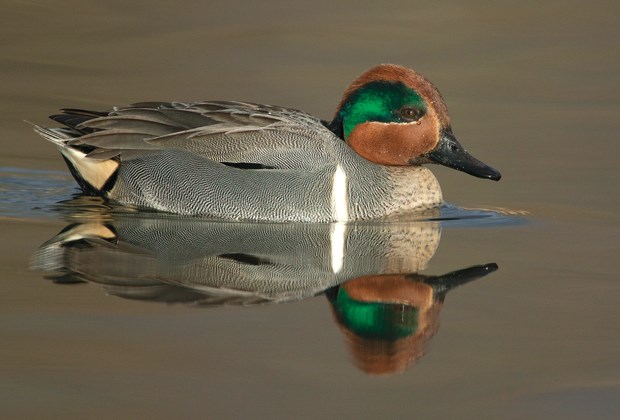Midwinter brings many wonderful birding opportunities to the North Shore's parks and natural areas.
For example, it's the best time of the year to enjoy a fine diversity of waterfowl.
Local waterfowl can be classified into swans, geese and ducks. Ducks are further divided into divers, dabblers, mergansers, sea ducks and stiff-tail ducks. Swans are not as common on the North Shore as they are in the Lower Fraser Valley where they often feed on waste crops, like carrots. Most often, trumpeter swans are seen flying over but they have landed at The Conservation Area at Maplewood Flats in past winters.
The Canada is our most common goose species, but there are others, like the cackling and the whitefronted. Several years ago the Canada goose was split into two species with the smaller sub-species lumped together as the cackling goose.
Dabbling ducks, sometimes called puddle ducks, include the familiar mallard and its relatives like the wood duck, gadwall, American wigeon, green-winged teal and northern pintail. Dabblers are often in mixed groups. For example, at Maplewood Flats, it's usual to see several species feeding together. Watch also for the rarer Eurasian wigeon both at Maplewood and Ambleside.
Divers, a diverse group usually seen in deeper water, includes the bufflehead, goldeneyes (two species), scaup (two species), and canvasback, scoters (three species). The ring-necked duck, another diver, is a bird of ponds like Maplewood's west pond, and the one at Ambleside. The beautiful Harlequin duck is seen in marine habitats, hunting for tasty fare like small crabs.
Mergansers, specialists in catching fish, are often called sawbills because they have serrated bills to help them catch slippery prey. Three species occur locally: the common, hooded and red-breasted. The beautiful hoody with its fan-shaped crest should be looked for in habitats like ponds, which are also good places to watch for the rainbow-coloured wood duck.
Watch for ducks courting, like mallards facing each other and nodding their heads up and down, or goldeneyes which snap their heads back, with a nasal wa-wa! Owls have recently been heard calling at night. Our most commonly seen owl on the North Shore is the barred owl. It has an easy to remember "who cooks for you... who cooks for you - all?" call. Other owl species to watch for include the great horned, saw whet and northern pygmy. A good way to find owls is to listen for scolding birds like chickadees, kinglets, wrens and jays. They're never wrong at discovering something. It might be an owl, a hawk, but it could also be a raven, raccoon, or even a domestic cat. If you see a flock (murder) of crows carrying on by calling excitedly and diving at a tree, check it out.
At Maplewood Flats we recently discovered a great horned owl. Actually, the crows found it for us.
Spring-like mild weather means bird song. It's only midwinter, but already there's a very distinct dawn chorus, which is why it's a good idea to start early in the morning on a birding outing.
Anna's hummingbird, our resident species, has been seen courting and heard singing of late because it nests in winter. Later in spring, the rufous hummingbird will arrive from wintering in Mexico.
Listen for eagles chirping; chickadees singing 'tea-time'; redwings doing their 'onka-ree"; and woodpeckers drumming.
Indeed, midwinter is a wonderful time of the year to enjoy nature on the North Shore.
Keep safe.
Al Grass is a naturalist with Wild Bird Trust of British Columbia, which offers free walks at The Conservation Area at Maplewood Flats on the second Saturday of every month, starting at 10 a.m. Meet at WBT's site office, 2645 Dollarton Hwy. Walks go rain or shine.



